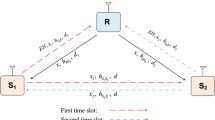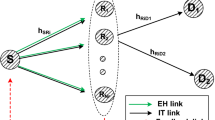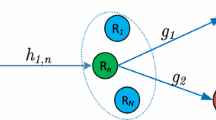Abstract
In this paper, we consider a dual-hop multiple-input multiple-output (MIMO) simultaneous wireless information and power transfer (SWIPT) relay network, where the source node (SN) uses a transmission antenna selection (TAS) scheme to concurrently send information and energy to the single-antenna relay node (RN). This helps to utilize the harvested energy to forward the received signal. In addition, the destination node (DN) employs the maximum ratio combining (MRC) scheme to process this forwarded signal. The performance of this MIMO SWIPT relay system is investigated in imperfect channel state information (CSI) condition. Specifically, we derive the exact and approximate closed-form expressions for the outage probability, the average capacity, and the symbol error probability (SEP). This is the first time the exact and approximate formulas for the SEP of the energy harvesting networks are investigated. The Monte Carlo simulation results are provided to demonstrate the relevance of the developed analytical results, showing that the system’s performance is significantly impacted by the CSI imperfection, the number of antennas, and the energy harvesting duration.











Similar content being viewed by others
Notes
6G will start entering the market by 2026 [1]
The proposed analysis approach can also be applied to the power spitting EH model [6].
The covariance between x and y is given as [35] \(\rho =\frac {cov(x,y)}{{var(x)var(y)}}\).
Recently, there are several articles investigating EH from the co-channel interference deployed in the future 5G network, and EH from the interference in IoT network.
We assume that all energy harvested from the RF signals is consumed by the relay for forwarding the information to the destination.
To obtain (8), we use the probability that any k of the N elements are below y. Hence, we need to enumerate the number of combinations of k out of N variables. This is merely the binomial coefficient. Then, we differentiate the result with respect to y.
We consider the MRC scheme employed at D since MRC always outperforms any other diversity combining schemes.
Abbreviations
- P r(.):
-
Probability function
- f U(u):
-
Probability density function (PDF)
- F U(u):
-
Cumulative distribution function (CDF)
- Γ(⋅),:
-
Gamma function
- \({\Gamma } \left ({ \cdot , \cdot } \right )\) :
-
Incomplete gamma function
- \(\mathcal {CN}(\mu ,\sigma ^{2})\) :
-
Circularly symmetric complex normal distribution with mean \(\mu \) and variance \(\sigma ^{2}\)
- \(\mathbb {E}\left \{\cdot \right \}\) :
-
Statistical expectation operator
- \({\mathcal {K}}_{n}\left (\cdot \right )\) :
-
Modified Bessel function of the second kind of order n
- \(E_{n}\left (. \right )\) :
-
Integral exponential function of order n
- W ℓ,μ(.):
-
Whittaker function [32]
References
David K, Berndt H (2018) 6G vision and requirements: is there any need for beyond 5G. IEEE Veh Technol Mag (13)3:72–80
Nguyen LD (2018) Resource allocation for energy efficiency in 5G wireless networks. EAI Endorsed Trans Ind Netw Intell Syst 5:14
Varshney LR (2008) Transporting information and energy simultaneously. In: Proceedings of 2008 IEEE international symposium on information theory. IEEE, pp 1612–1616
Lu X, Wang P, Niyato D, Kim DI, Han Z (2015) Wireless networks with RF energy harvesting: a contemporary survey. IEEE Commun Surv Tutorials 17(2):757–789
Zhang R, Ho CK (2013) MIMO Broadcasting for simultaneous wireless information and power transfer. IEEE Trans Commun 12(5):1989–2001
Zhou X, Zhang R, Ho CK (2013) Wireless information and power transfer: architecture design and rate-energy tradeoff. IEEE Trans Commun 61(11):4754–4767
Ding Z, Perlaza SM, Esnaola I, Poor HV (2014) Power allocation strategies in energy harvesting wireless cooperative networks. IEEE Trans Wirel Commun 13(2):846–860
Nasir AA, Zhou X, Durrani S, Kennedy RA (2013) Relaying protocols for wireless energy harvesting and information processing. IEEE Trans Wirel Commun 12(7):3622–3636
Do NT, da Costa DB, Duong TQ, Bao VNQ, An B (2017) Exploiting direct links in multiuser multirelay SWIPT cooperative networks with opportunistic scheduling. IEEE Trans Wirel Commun 16(8):5410–5427
Dong Y, Hossain MJ, Cheng J (2016) Performance of wireless powered amplify and forward relaying over nakagami-m fading channels with nonlinear energy harvester. IEEE Commun Lett 20(4):672–675
Do TN, da Costa DB, Duong TQ, An B (2018) Improving the performance of cell-edge users in MISO-NOMA systems using TAS and SWIPT-based cooperative transmissions. IEEE Trans Green Commun Netw 2(1):49–62
Do NT, Da Costa DB, Duong TQ, An B (2017) A BNBF user selection scheme for NOMA-based cooperative relaying systems with SWIPT. IEEE Commun Lett 21(3):664–667
Hoang TM, Van Son V, Dinh NC, Hiep PT (2018) Optimizing duration of energy harvesting for downlink NOMA full-duplex over Nakagami-m fading channel. AEU-Int J Electron Commun 95:199–206
Hoang TM, Tan NT, Hoang NH, Hiep PT Performance analysis of decode-and-forward partial relay selection in NOMA systems with RF energy harvesting, Wireless Networks, pp 1–11. https://doi.org/10.1007/s11276-018-1746-8
Radaydeh RM (2009) Impact of delayed arbitrary transmit antenna selection on the performance of rectangular QAM with receive MRC in fading channels. IEEE Commun Lett 6:13
Suraweera HA, Soysa M, Tellambura C, Garg HK (2010) Performance analysis of partial relay selection with feedback delay. IEEE Signal Process Lett 17(6):531–534
Michalopoulos DS, Chatzidiamantis ND, Schober R, Karagiannidis GK (2011) Relay selection with outdated channel estimates in Nakagami-m fading. In: Proceedings of 2011 IEEE international conference on communications (ICC). IEEE, pp 1–6
Ferdinand NS, da Costa DB, Latva-aho M (2013) Effects of outdated CSI on the secrecy performance of MISO wiretap channels with transmit antenna selection. IEEE Commun Lett 17(5):864–867
Amarasuriya G, Larsson EG, Poor HV (2016) Wireless information and power transfer in multiway massive MIMO relay networks. IEEE Trans Wirel Commun 15(6):3837–3855
Zhao L, Wang X, Zheng K (2016) Downlink hybrid information and energy transfer with massive MIMO. IEEE Trans Wirel Commun 15(2):1309–1322
Shi Q, Xu W, Wu J, Song E, Wang Y (2015) Secure beamforming for MIMO broadcasting with wireless information and power transfer. IEEE Trans Wirel Commun 14(5):2841–2853
Zhang Q, Li Q, Qin J (2016) Beamforming design for OSTBC-based AF-MIMO two-way relay networks with simultaneous wireless information and power transfer. IEEE Trans Veh Commun 65(9):7285–7296
Bao VNQ, Duong TQ, Tellambura C (2013) On the performance of cognitive underlay multihop networks with imperfect channel state information. IEEE Trans Wirel Commun 61(12):4864–4873
Fan L, Lei X, Yang N, Duong TQ, Karagiannidis GK (2017) Secrecy cooperative networks with outdated relay selection over correlated fading channels. IEEE Trans Veh Commun 66(8):7599–7603
Huang Y, Al-Qahtani FS, Duong TQ, Wang J (2015) Secure transmission in MIMO wiretap channels using general-order transmit antenna selection with outdated CSI. IEEE Trans Wirel Commun 63(8):2959–2971
Lee K, Hong J-P (2016) Energy-efficient resource allocation for simultaneous information and energy transfer with imperfect channel estimation. IEEE Trans Veh Commun 65(4):2775– 2780
Benkhelifa F, Salem AS, Alouini M-S (2016) Rate maximization in MIMO decode-and-forward communications with an EH relay and possibly imperfect CSI. IEEE Trans Wirel Commun 64(11):4534–4549
Prasad B, Roy SD, Kundu S (2015) Secondary throughput in underlay cognitive radio network with imperfect CSI and energy harvesting relay. In: Proceedings of 2015 IEEE international conference on advanced networks and telecommunications systems (ANTS). IEEE, pp 1–6
Zhang J, Pan G (2016) Outage analysis of wireless-powered relaying MIMO systems with non-linear energy harvesters and imperfect CSI. IEEE Access 4:7046–7053
Yilmaz A, Kucur O (2012) Performance of transmit antenna selection and maximal-ratio combining in dual hop amplify-and-forward relay network over Nakagami-m fading channels. Wirel Pers Commun 3(67):485–503
Mohammadi M, Chalise BK, Suraweera HA, Zhong C, Zheng G, Krikidis I (2016) Throughput analysis and optimization of wireless-powered multiple antenna full-duplex relay systems. IEEE Trans Commun 64 (4):1769–1785
Gradshteyn IS, Ryzhik IM (2014) Table of integrals, series, and products. Academic Press, Cambridge
Rajesh R, Sharma V, Viswanath P (2014) Capacity of gaussian channels with energy harvesting and processing cost. IEEE Trans Inf Theory 60(5):2563–2575
Suraweera HA, Smith PJ, Shafi M (2010) Capacity limits and performance analysis of cognitive radio with imperfect channel knowledge. IEEE Trans Veh Commun 59(4):1811–1822
Papoulis A, Pillai SU (2002) Probability, random variables, and stochastic processes. Tata McGraw-Hill Education, New York
Ahn KS, Heath JRW (2009) Performance analysis of maximum ratio combining with imperfect channel estimation in the presence of cochannel interferences. IEEE Trans Wirel Commun 8(3):1080–1085
Simon MK, Alouini M-S (2002) Digital communication over generalized fading channels: a unified approach to performance analysis. Wiley, New York
Van Khuong H, Kong H-Y (2006) General expression for eps of a sum of independent exponential random variables. IEEE Commun Lett 10(3):159–161
Tang J, Zhang X (2006) Transmit selection diversity with maximal-ratio combining for multicarrier DS-CDMA wireless networks over Nakagami-m fading channels. IEEE J Sel Areas Commun 24(1):104–112
Bao VNQ, Kong HY (2010) Performance analysis of decode-and-forward relaying with partial relay selection for multihop transmission over Rayleigh fading channels. J Commun Netw 12(5):433–441
Laneman JN, Tse DN, Wornell GW (2004) Cooperative diversity in wireless networks: efficient protocols and outage behavior. IEEE Trans Inf Theory 50(12):3062–3080
Abramowitz M, Stegun IA (1965) Handbook of mathematical functions: with formulas, graphs, and mathematical tables. Dover Publications, New York
Chen Y, Tellambura C (2004) Distribution functions of selection combiner output in equally correlated Rayleigh, Rician, and Nakagami-m fading channels. IEEE Trans Wirel Commun 52(11):1948–1956
Goldsmith A (2005) Wireless communications. Cambridge University Press, Cambridge
Author information
Authors and Affiliations
Corresponding author
Appendices
Appendix A
Aiming at the closed-form formulations for \(I_{2}^{\text {Exact}}\) and \(I_{2}^{\text {Appro}}\), we start by determining the corresponding constituent integral as follows: Substituting (23)–(29) and carrying out some manipulations, we have
With the help of [32, 6.643.3], \(I_{2}^{\text {Appro}}\) is then obtained as in Eq. 32.
Similarly, for the case of \(I_{2}^{\text {Exact}}\), substituting the exact CDF in Eqs. 24–29, it hence is recast as
With the help of [42, 5.1.45], and using \({E_{n}}\left (z \right ) = {z^{n - 1}}{\Gamma } \left ({1 - n, z} \right )\), \(I_{2}^{\text {Exact}}\) can then be recast as
For calculating \({\mathcal {I}}\left (x \right )\), [32, 6.455.1] is applied, and after some manipulations, we have
Using the [32, 3.361.2], we then obtain the closed-form formulation of \({I_{2}^{\text {Exact}}}\).
Appendix B
Starting from statistical expectation formulation \({\mathbb {E}}\{\gamma _{\text {e2e}}\} = \int \limits _{0}^{\infty } \left [1- F_{\gamma _{\text {e2e}}}(x)\right ]dx\) with the CDF of (23), after some manipulations, we can rewrite \({\mathbb {E}}\{\gamma _{\text {e2e}}\}\) as
Let \(\sqrt x = u\) and using [32, 6.561.16], we then have \(\mathbb {E}\{\gamma _{\text {e2e}}\}\) expressed as
Substituting (44)–(36), we then have the average capacity formulation of Eq. 37.
Similarly, the average end-to-end SNR is given by
With the help of [42, 5.1.45], we can rewrite (45) as
Thank to the help of [42, 6.5.37], and after some modifications, we have
Replacing (47)–(36), we then obtain the average capacity as in Eq. 38.
Rights and permissions
About this article
Cite this article
Hoang, T.M., Tran, X.N., Thanh, N. et al. Performance Analysis of MIMO SWIPT Relay Network with Imperfect CSI. Mobile Netw Appl 24, 630–642 (2019). https://doi.org/10.1007/s11036-018-1163-3
Published:
Issue Date:
DOI: https://doi.org/10.1007/s11036-018-1163-3




